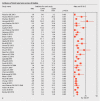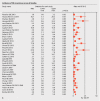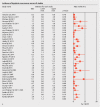Recurrence of intestinal metaplasia and early neoplasia after endoscopic eradication therapy for Barrett's esophagus: a systematic review and meta-analysis
- PMID: 28573176
- PMCID: PMC5451278
- DOI: 10.1055/s-0043-106578
Recurrence of intestinal metaplasia and early neoplasia after endoscopic eradication therapy for Barrett's esophagus: a systematic review and meta-analysis
Abstract
Background: Conflicting data exist with regard to recurrence rates of intestinal metaplasia (IM) and dysplasia after achieving complete eradication of intestinal metaplasia (CE-IM) in Barrett's esophagus (BE) patients.
Aim: (i) To determine the incidence of recurrent IM and dysplasia achieving CE-IM and (ii) to compare recurrence rates between treatment modalities [radiofrequency ablation (RFA) with or without endoscopic mucosal resection (EMR) vs stepwise complete EMR (SRER)].
Methods: A systematic search was performed for studies reporting on outcomes and estimates of recurrence rates after achieving CE-IM. Pooled incidence [per 100-patient-years (PY)] and risk ratios with 95 %CI were obtained. Heterogeneity was measured using the I2 statistic. Subgroup analyses, decided a priori, were performed to explore heterogeneity in results.
Results: A total of 39 studies were identified (25-RFA, 13-SRER, and 2 combined). The pooled incidence of any recurrence was 7.5 (95 %CI 6.1 - 9.0)/100 PY with a pooled incidence of IM recurrence rate of 4.8 (95 %CI 3.8 - 5.9)/100 PY, and dysplasia recurrence rate of 2.0 (95 %CI 1.5 - 2.5)/100 PY. Compared to the SRER group, the RFA group had significantly higher overall [8.6 (6.7 - 10.5)/100 PY vs. 5.1 (3.1 - 7)/100 PY, P = 0.01] and IM recurrence rates [5.8 (4.3 - 7.3)/100 PY vs. 3.1 (1.7 - 4)/100 PY, P < 0.01] with no difference in recurrence rates of dysplasia. Significant heterogeneity between studies was identified. The majority of recurrences were amenable to repeat endoscopic eradication therapy (EET).
Conclusion: The results of this study demonstrate that the incidence rates of overall, IM, and dysplasia recurrence rates post-EET are not inconsiderable and reinforce the importance of close surveillance after achieving CE-IM.
Conflict of interest statement
Figures





References
-
- Pohl H, Welch H G. The role of overdiagnosis and reclassification in the marked increase of esophageal adenocarcinoma incidence. J Natl Cancer Inst. 2005;97:142–146. - PubMed
-
- Lepage C, Rachet B, Jooste V et al.Continuing rapid increase in esophageal adenocarcinoma in England and Wales. Am J Gastroenterol. 2008;103:2694–2699. - PubMed
-
- Polednak A P. Trends in survival for both histologic types of esophageal cancer in US surveillance, epidemiology and end results areas. Int J Cancer. 2003;105:98–100. - PubMed
LinkOut - more resources
Full Text Sources
Other Literature Sources
Medical

